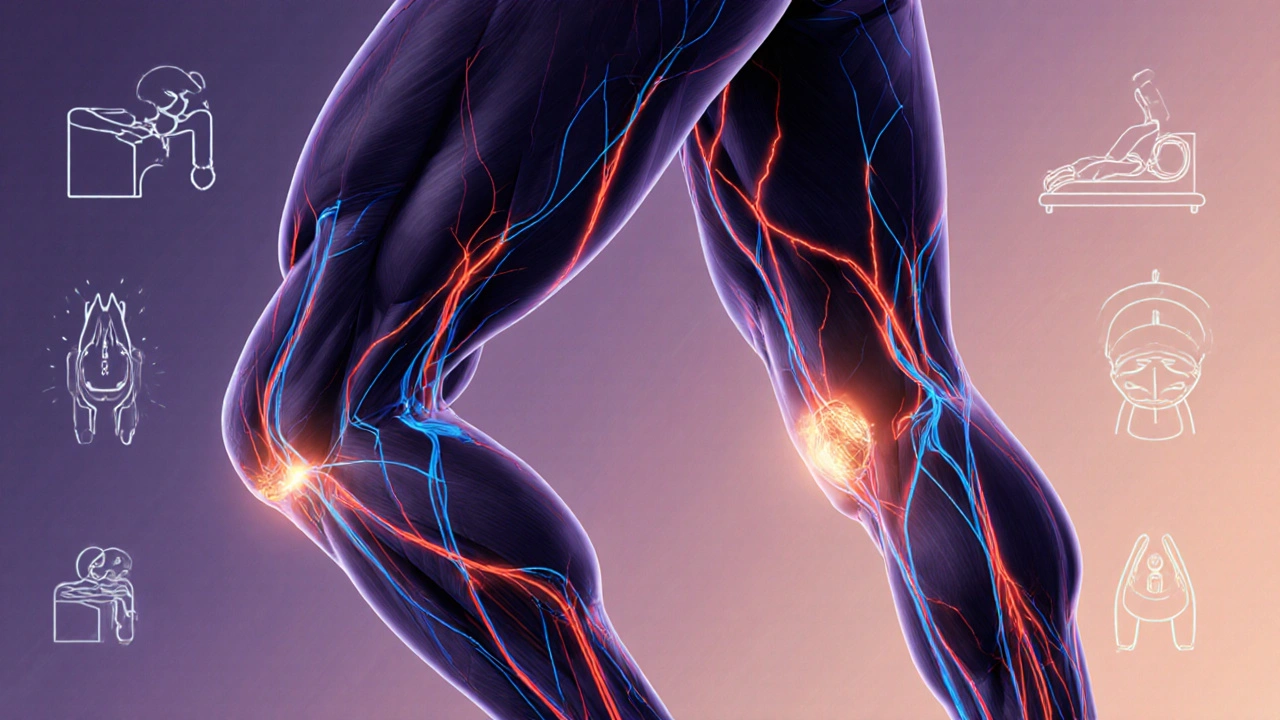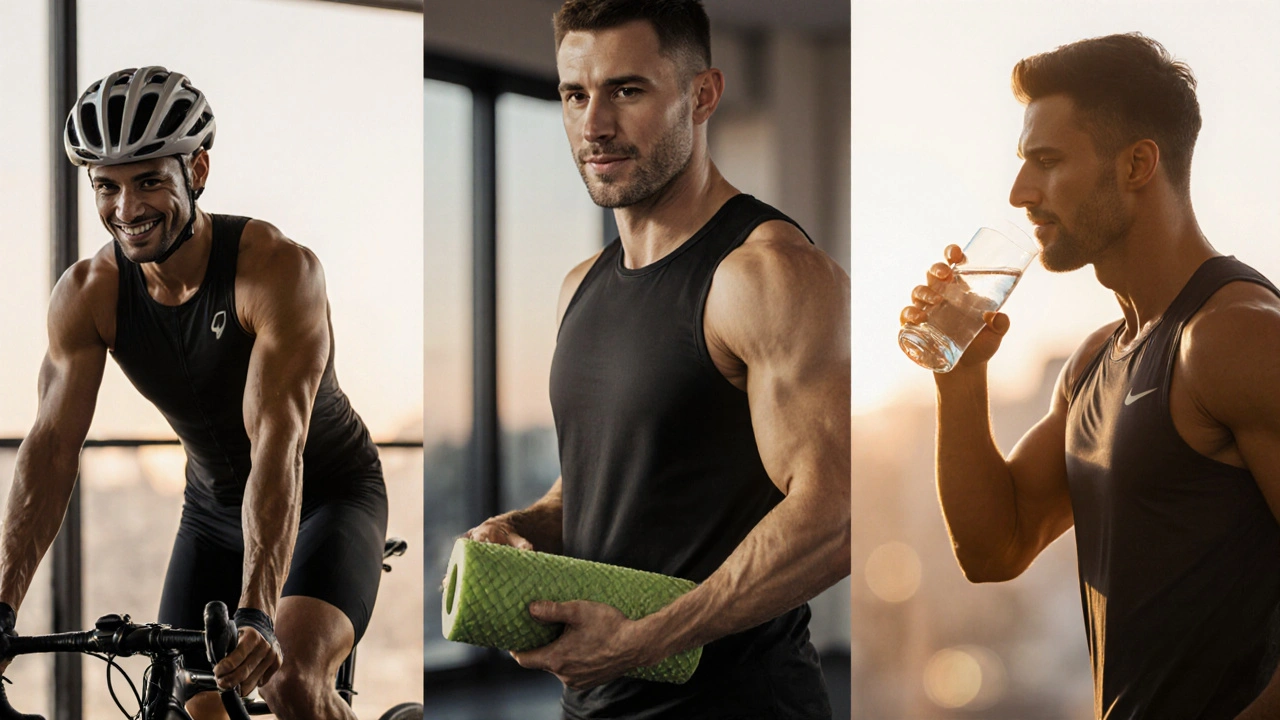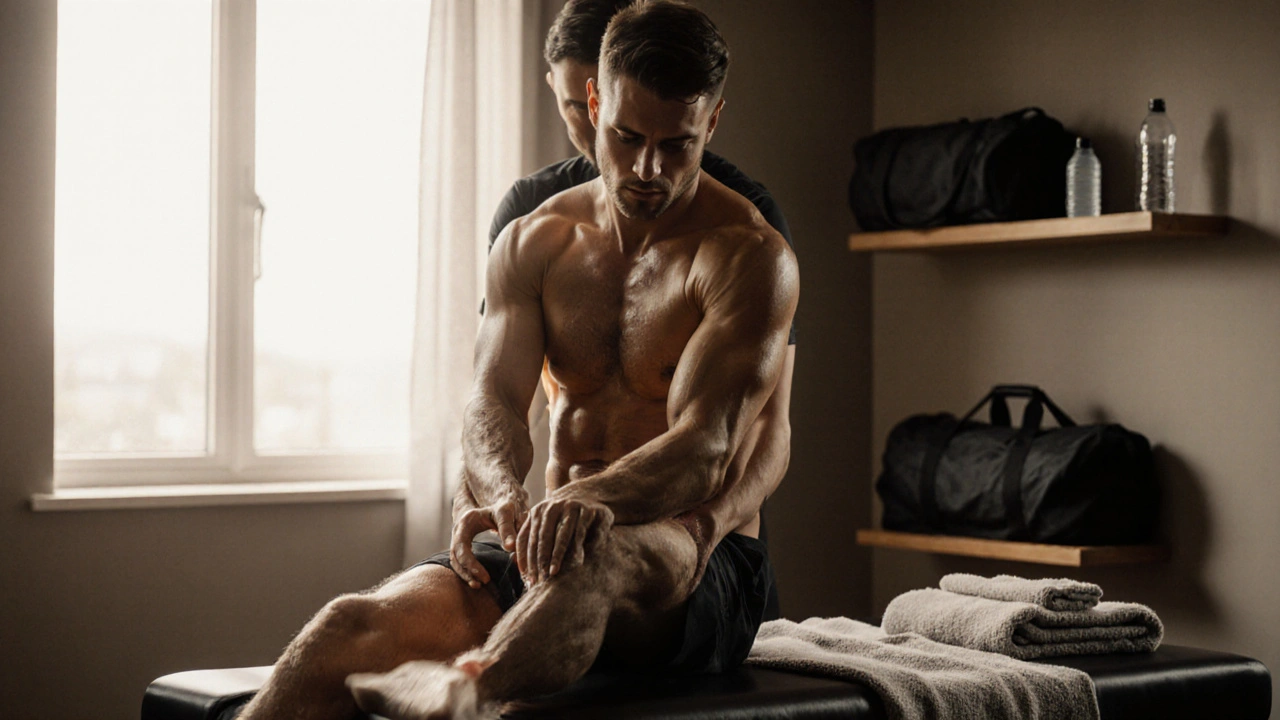After a tough workout, your muscles don’t just bounce back on their own. You feel stiff, sore, and heavy-like your body is holding onto every drop of effort. That’s not just fatigue. It’s inflammation, micro-tears, and metabolic waste building up where your muscles worked hardest. Many athletes push through it, hoping rest will fix everything. But what if there’s a faster, more effective way? Sports massage isn’t just a luxury for pros-it’s a proven tool that speeds up recovery, reduces soreness, and gets you back to training sooner.
What Happens to Your Muscles After a Hard Workout?
When you lift weights, sprint, or train intensely, your muscle fibers experience tiny tears. Your body responds by triggering inflammation-a natural healing process. Blood flow increases to the area, bringing oxygen and nutrients. At the same time, metabolic byproducts like lactic acid and creatine kinase pile up. These aren’t toxins, but they contribute to that burning, heavy feeling you get 12 to 48 hours after exercise. That’s delayed onset muscle soreness, or DOMS.
Left alone, your body will heal. But healing isn’t always efficient. Scar tissue can form, muscles stay tight, and circulation stays sluggish. That’s where sports massage steps in. It’s not about deep pressure just to hurt-it’s targeted, rhythmic, and timed to support your body’s natural repair cycle.
How Sports Massage Speeds Up Recovery
Sports massage works in three key ways: improving circulation, reducing muscle tension, and lowering inflammation.
First, it boosts blood flow. A 2019 study from the Journal of Athletic Training showed that athletes who received massage after intense leg workouts had 30% higher blood flow to the quadriceps compared to those who just rested. More blood means more oxygen and nutrients delivered to damaged tissue-and faster removal of waste products like lactic acid.
Second, it breaks up adhesions. After hard training, muscle fibers stick together. These sticky spots, called myofascial adhesions, limit movement and cause pain. Sports massage uses techniques like cross-fiber friction and trigger point release to gently separate those fibers. Think of it like untangling a knotted rope. You don’t yank it-you work it loose, strand by strand.
Third, it reduces inflammation markers. Research from the Journal of Sports Science & Medicine found that athletes who got sports massage after a marathon had lower levels of IL-6, a key inflammatory cytokine, within 24 hours. Less inflammation means less swelling, less pain, and quicker return to normal function.
When to Get a Sports Massage for Best Results
Timing matters. Getting a massage right after a workout isn’t always the best move. Your muscles are too inflamed. Waiting 24 to 48 hours gives your body time to begin healing naturally, then massage enhances it.
For endurance athletes-runners, cyclists, triathletes-getting a massage 24 to 36 hours after a long session is ideal. It helps flush out metabolic buildup and prevents stiffness from locking in.
For strength trainers, a session 48 hours after heavy lifting works best. That’s when DOMS peaks. Massage at this point can cut soreness by up to 50%, according to a 2021 meta-analysis in the British Journal of Sports Medicine.
Some athletes also use massage before events. A light 15- to 20-minute session before competition can increase range of motion and reduce anxiety. But it shouldn’t be deep or intense-just enough to wake up the muscles without causing fatigue.
What Makes Sports Massage Different from Regular Massage?
Not all massages are created equal. A Swedish massage is relaxing. A deep tissue massage might hurt on purpose. Sports massage is functional. It’s designed with one goal: optimize athletic performance and recovery.
Techniques vary based on the athlete’s needs:
- Effleurage: Long, gliding strokes to warm up tissue and increase circulation.
- Petrissage: Kneading motions that lift and squeeze muscles to release tension.
- Friction: Deep, focused pressure across muscle fibers to break up adhesions.
- Trigger Point Therapy: Holding pressure on tight knots until they release.
- Stretching: Passive or active movements to restore flexibility.
A good sports massage therapist knows your sport. They’ll focus on the muscles you use most. A cyclist gets work on hamstrings, glutes, and calves. A swimmer gets attention on shoulders, lats, and rotator cuffs. It’s not a one-size-fits-all session.

Who Benefits Most From Sports Massage?
You don’t have to be an elite athlete to benefit. Anyone who trains hard-whether it’s CrossFit, weekend hiking, or daily HIIT-can see real improvements.
Here’s who sees the biggest gains:
- Endurance athletes: Marathoners, cyclists, rowers. They push their bodies for hours. Massage helps manage cumulative fatigue.
- Strength athletes: Weightlifters, powerlifters, bodybuilders. Heavy loads create micro-tears. Massage helps them recover faster between sessions.
- Team sport players: Soccer, basketball, hockey players. Frequent games and practices mean little time to recover. Massage keeps them injury-free.
- Recreational exercisers: People who train 3-5 times a week. They often skip recovery, then wonder why they’re always sore. Massage breaks that cycle.
Even people recovering from minor injuries-like a pulled hamstring or tight IT band-can use sports massage as part of rehab, as long as it’s done by a licensed therapist who understands injury protocols.
What to Expect During Your First Session
Don’t walk in expecting a spa day. A sports massage session usually lasts 60 to 90 minutes. You’ll be asked about your training routine, recent injuries, and areas of tightness. The therapist will likely assess your posture and movement before starting.
You’ll be draped with a sheet, and only the area being worked on will be exposed. It’s not always comfortable-some pressure will feel intense. But it shouldn’t be unbearable. If it hurts too much, speak up. Good therapists adjust on the fly.
Afterward, you might feel slightly sore for a day. That’s normal. Drink plenty of water. Avoid intense workouts for 24 hours. Your body is still healing.
Common Myths About Sports Massage
There’s a lot of misinformation out there. Let’s clear up a few:
- Myth: Massage removes lactic acid. Truth: Lactic acid clears naturally within an hour. Massage helps with other waste products and improves circulation, but it’s not a detox.
- Myth: You need to be in pain to benefit. Truth: Prevention is better than cure. Regular massage-even when you’re not sore-keeps muscles loose and responsive.
- Myth: More pressure = better results. Truth: Excessive force can damage tissue. Effective sports massage uses precise pressure, not brute strength.
- Myth: One session fixes everything. Truth: Recovery is cumulative. Like training, massage works best with consistency.

How Often Should You Get a Sports Massage?
There’s no universal rule. It depends on your training load.
For casual exercisers (3-4 days a week): Once every 3-4 weeks helps maintain mobility and prevent tightness.
For serious athletes (5+ days a week or competitive): Once a week during peak training. Every two weeks during maintenance phases.
For those recovering from injury: 1-2 times a week, as advised by a physiotherapist.
Some people use at-home tools like foam rollers or massage guns. They’re helpful for daily maintenance, but they can’t replace the precision and feedback of a trained therapist. Think of them as a daily snack-not a full meal.
Where to Find a Qualified Sports Massage Therapist
Not every massage therapist knows sports recovery. Look for someone with:
- Certification in sports massage (CIMT, NCTMB, or equivalent)
- Experience working with athletes in your sport
- Knowledge of anatomy and movement patterns
- Good communication-they ask questions, don’t just start massaging
Ask your trainer, physiotherapist, or local running club for recommendations. In Vancouver, clinics near Granville Island or Kitsilano often specialize in athletic recovery. Don’t be afraid to ask for a consultation before booking your first session.
Real Results: What Athletes Say
Jess, a 38-year-old runner from Burnaby, started getting weekly sports massages after her third marathon. She used to take 10 days to recover from a 20-miler. Now, she’s back to light jogging in 48 hours. "I used to think rest meant lying on the couch. Now I know recovery means active healing. My massage therapist is my secret weapon."
Mark, a CrossFit competitor, missed three competitions because of shoulder impingement. After six weeks of sports massage combined with mobility work, he returned to the box pain-free. "It wasn’t magic. It was consistency. I showed up, even when I didn’t feel like it."
These aren’t outliers. They’re people who treated recovery like part of their training-and saw the difference.
Does sports massage help with muscle soreness?
Yes. Multiple studies show sports massage reduces DOMS by up to 50%. It doesn’t eliminate soreness completely, but it significantly lowers intensity and shortens the duration. The effect is strongest when massage is done 24-48 hours after intense exercise.
Can sports massage prevent injuries?
It doesn’t guarantee injury prevention, but it reduces risk. Tight muscles and adhesions limit range of motion and alter movement patterns, which increases strain on joints and tendons. Regular massage keeps muscles flexible and balanced, helping you move more efficiently and avoid overuse injuries.
Is sports massage painful?
It can be uncomfortable, especially in tight areas, but it shouldn’t be excruciating. A good therapist works within your tolerance. Pain that makes you tense up defeats the purpose-relaxation is part of healing. If it hurts too much, speak up. Pressure should feel like a "good hurt," not a "stop-it" hurt.
How long do the effects of a sports massage last?
The immediate benefits-like reduced soreness and improved range of motion-last 24 to 72 hours. But the long-term benefits, like fewer adhesions and better muscle function, build over time with regular sessions. Think of it like brushing your teeth: one session helps, but consistency keeps things healthy.
Can I do sports massage at home with a foam roller?
Foam rollers and massage guns are great for daily maintenance and self-care. They help release tension and improve circulation between professional sessions. But they can’t match the precision, depth, and feedback of a trained therapist. Use them as a supplement, not a replacement.
If you’re serious about your training, recovery isn’t optional. It’s part of your plan. Sports massage isn’t a quick fix-it’s a smart habit. Treat it like your warm-up or your protein shake. Show up. Stay consistent. Let your body recover the way it was meant to.






